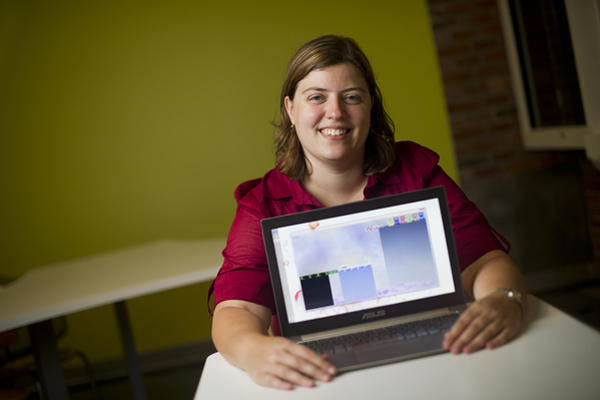Computers for crafting?

Computers were designed to do complex mathematical calculations, like mapping the trajectory of a bullet. But according to new faculty member Gillian Smith, it’s not so easy for a computer to understand concepts like fun, friendship and love.
“We don’t find games that are about those topics because we don’t know how to model them,” she explains.
Smith, an assistant professor with joint appointments in the College of Arts, Media and Design and the College of Computer and Information Science, hopes to change that. “I am interested in figuring out how computers can help people be a little bit more creative and how computers could be creative themselves,” she says.
Smith is exploring ways to bring crafting and computers together with both digital tools and games. A startup company called Play Crafts, which Smith co-founded with two friends she met at the University of California, Santa Cruz, gives tech-based design tools to quilters, sewers and other crafters.
One tool, for example, automatically generates a color palette from a user-uploaded photo. “Different people love doing different parts of craft,” Smith says. “We want to make it so a computer can help with the parts you’re less experienced with or find less enjoyable, so we can make it more fun.”
In her academic work, Smith is also pursuing platforms where computers and crafts intersect. She is interested in designing games, or “playable experiences,” which present users with tasks and design limitations to guide their actual quilting, embroidering or sewing.
The idea calls to mind an important question regarding the nature of gaming and creativity: What, exactly, is a game? And more specifically, if a user is required to sew a button where he wouldn’t have otherwise planned to, would that inhibit his own natural creative process?
“I find that where I feel the most creative comes from a constraint I’ve been given that I may not necessarily know about ahead of time,” Smith says.
Perhaps unsurprisingly, Smith uses constraints to teach game design, which, she says, “forces you to think in a direction you might not have thought before.”
If all of this sounds relatively out of the box, that’s because it is. The computer science field is still dominated by men, whereas the crafting population is mainly made up of women. It’s no wonder, then, that the two areas haven’t traditionally overlapped much, but, as Smith explained, “I’m interested in finding ways to use computers to diversify computer science.”





